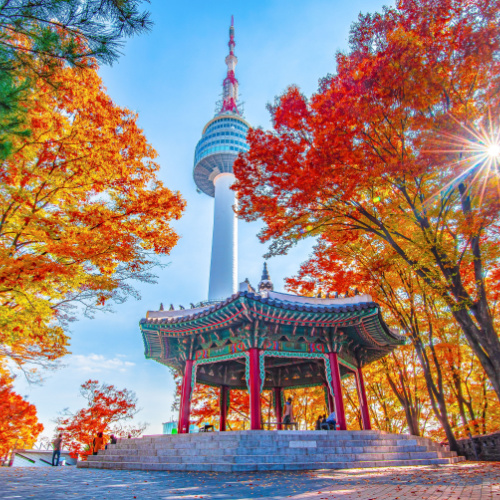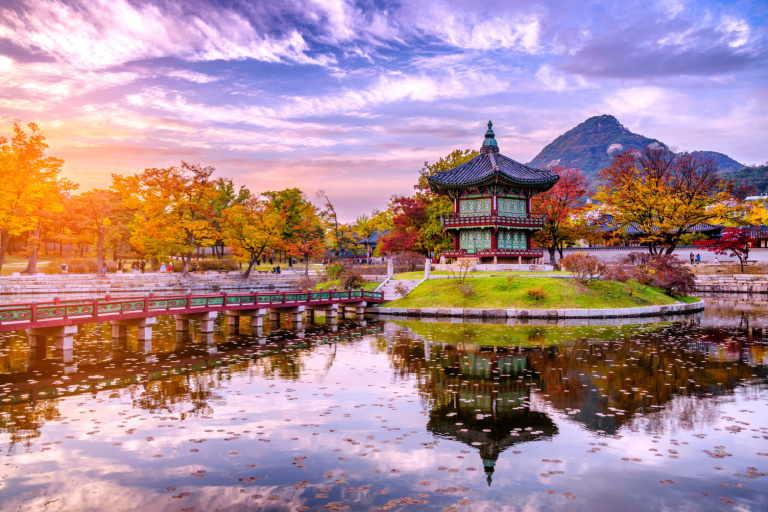
ONRUECHA WASAN/Shutterstock
When Is the Best Time to Visit South Korea?
The best time to visit South Korea is during the shoulder seasons of spring (April to May) and autumn (September to October). During these months, the weather is generally mild and sunny, with fewer crowds and lower prices than during the peak summer (June to August) and winter (November to February) seasons.
Here are some of the benefits of visiting South Korea during the shoulder seasons:
- Mild weather: South Korea has a temperate climate, but the shoulder seasons offer the most pleasant weather, with average temperatures ranging from 15 to 25 degrees Celsius (59 to 77 degrees Fahrenheit). This makes it ideal for sightseeing, exploring, and enjoying the outdoors.
- Smaller crowds: The shoulder seasons are less crowded than the peak summer and winter seasons, so you’ll be able to enjoy South Korea’s popular tourist attractions without having to deal with large crowds. This is especially important if you’re visiting popular destinations like Seoul, Busan, and Jeju Island.
- Lower prices: Prices for flights, accommodation, and activities are generally lower during the shoulder seasons than during the peak summer and winter seasons. This means you can save money on your trip without having to sacrifice quality.
Here are some specific examples of how you can enjoy the most of South Korea during the shoulder seasons:
- Spring: Spring in South Korea is a beautiful time to visit, with the cherry blossoms in bloom. Popular activities during this time of year include visiting cherry blossom festivals, hiking in the mountains, and picnicking in the parks.
- Autumn: Autumn in South Korea is another beautiful time to visit, with the leaves changing color. Popular activities during this time of year include visiting temples and palaces, hiking in the mountains, and enjoying the cooler weather.
While there are many great times to visit South Korea, if you’re looking for the best weather, fewer crowds, and lower prices, then we recommend visiting during the shoulder seasons of April to May and September to October.
 Average Temperatures by Month
Average Temperatures by Month
|
Jan |
Feb |
Mar |
Apr |
May |
Jun |
Jul |
Aug |
Sep |
Oct |
Nov |
Dec |
| Fahrenheit |
23°
|
29°
|
40°
|
54°
|
63°
|
72°
|
78°
|
79°
|
69°
|
56°
|
41°
|
29°
|
| Celsius |
-5°
|
-2°
|
4°
|
12°
|
17°
|
22°
|
26°
|
26°
|
21°
|
13°
|
5°
|
-2°
|
Climate in South Korea
Summer Season in South Korea
South Korean summers are hot and humid, with temperatures often rising significantly, especially in July and August. This season is characterized by long days with intense sunlight and is also marked by the monsoon period, bringing frequent and sometimes heavy rainfall, particularly in July. Despite the humidity and rain, summer is a vibrant time for outdoor festivals and cultural events.
Rainy Season in South Korea
The rainy season in South Korea, also known as the monsoon season, typically occurs in late June and July. It brings significant rainfall across the country, which can be heavy and continuous, particularly in the southern regions. This period is crucial for agriculture but can impact travel and outdoor activities due to wet conditions.
Winter Season in South Korea
Winters in South Korea are cold, with temperatures often dropping below freezing, especially in the northern regions, including Seoul. The country experiences snowfall, particularly in the mountainous areas, making it popular for winter sports. The season is marked by shorter days and clear, crisp weather, offering stunning winter landscapes and opportunities for unique cultural experiences, such as visiting traditional Korean saunas (jjimjilbang) and enjoying seasonal street food.
Our Recommendations
| Destination |
Jan |
Feb |
Mar |
Apr |
May |
Jun |
Jul |
Aug |
Sep |
Oct |
Nov |
Dec |
| South Korea |
 |
 |
 |
 |
 |
 |
 |
 |
 |
 |
 |
 |






